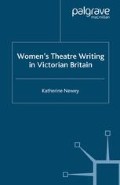Abstract
In 1908, Elizabeth Robins used the language of collective political action to declare war on the ‘Exceptional Woman’ for the sake of all women’s progress, rather as Virginia Woolf later wrote about the need to murder the Angel of the House to enable women writers to work freely. In this concluding chapter, I want to look at the careers of some women who worked outside the framework of the ‘Exceptional Woman’ or ‘exceptionality’ as it was constructed earlier in the century: writers of the second or third rank (if we’re counting this way) who included playwriting as a normal part of their ‘portfolio careers’ as professional writers, or as Susan Croft titled her bibliography She Also Wrote Plays.1 Florence Bell, Florence Marryat, and Lucy Clifford were all successful playwrights, whose reputations rested largely on other work, and in this way are representative of many other women in the literary marketplace at the end of the century. Apart from Florence Bell, wife of industrialist Hugh Bell, these women made their livings of necessity by their writing. They were all well-connected, educated, middle- and upper-middle class — indeed Marryat was at various times quite a wealthy woman through her work — and all were vitally interested in the theatre, both as another avenue for income and professional recognition, but also for its own sake.
Access this chapter
Tax calculation will be finalised at checkout
Purchases are for personal use only
Preview
Unable to display preview. Download preview PDF.
Notes
Susan Croft, She Also Wrote Plays: An International Guide to Women Playwrights from the 10th to the 21s Century (London: Faber and Faber, 2001).
Tracy C. Davis, Actresses as Working Women (London and New York: Routledge, 1991), 10
and Tracy C. Davis, ‘Laborers of the Nineteenth-Century Theater: The Economies of Gender and Theatrical Organization,’ Journal of British Studies, 33: 1 (January 1994), 50–1.
Elizabeth Robins, Theatre and Friendship: Some Henry James Letters with a Commentary (London: Jonathan Cape, 1932), 17.
Florence Bell, ‘Introduction,’ At the Works: A Study of a Manufacturing Town (1907; New York: Augustus M. Kelley, 1969), x.
For one of the few recent discussions of Bell’s social investigation, see Deborah Epstein Nord, Walking the Victorian Streets: Women, Representation, and the City (Ithaca and London: Cornell University Press, 1995), 227–30.
Reprinted in Florence Bell, Landmarks. A Reprint of some Essays and other Pieces Published Between the Year 1894 and 1922 (London: Ernest Benn, 1929).
Florence Bell, The Way the Money Goes (London: Sidgwick & Jackson, 1910).
Florence Bell and Elizabeth Robins, Alan’s Wife in Linda Fitzsimmons and Viv Gardner (eds), New Woman Plays (London: Methuen, 1991), 19.
Catherine Wiley, ‘Staging Infanticide: The Refusal of Representation in Elizabeth Robins’s Alan’s Wife,’ Theatre Journal, 42: 4 (1990), 433.
Elin Diamond, Unmaking Mimesis (London and New York: Routledge, 1997), 37.
Cited in Angela V. John, Elizabeth Robins: Staging a Life, 1862–1952 (London and New York: Routledge, 1995), 89.
Tess Cosslett, Woman to Woman: Female Friendship in Victorian Fiction (Brighton: Harvester Press, 1988).
Clo. Graves, B. L. Farjeon, Florence Marryat, G. Manville Fenn, Mrs Campbell Praed, Justin Huntly McCarthy, and Clement Scott, The Fate of Fenella (London: Hutchinson, 1892),
and Clo. Graves, B. L. Farjeon, Florence Marryat, G. Manville Fenn, Mrs Campbell Praed, Justin Huntly McCarthy, and Clement Scott, Seven Christmas Eves, Being the Romance of a Social Evolution (London: Hutchinson and Co. [1893]).
David Hannay, Life of Frederick Marryat (London: Walter Scott, 1889), 12.
Helen C. Black, Notable Women Authors of the Day (Glasgow: David Bryce and Son, 1893), 87. See also the card catalogue for the Lord Chamberlain’s Collection of Plays, British Library.
Talia Schaffer, The Forgotten Female Aesthetes, Literary Culture in Late-Victorian England (Charlottesville and London: University Press of Virginia, 2000), 41.
Andrew Maunder, ‘Introduction,’ to Florence Marryat, Love’s Conflict (1865; London: Pickering and Chatto, 2005). This is the best recent account of Marryaťs life and writing.
Edward Clodd, Memories (London: Chapman & Hall, 1916), 37–9.
See also Marysa Demoor and Monty Chisholm (eds), ‘Bravest of women and finest of friends’: Henry James’s Letters to Lucy Clifford (University of Victoria: English Literary Studies, 1999), 11–16.
Gordon S. Haight (ed.), The George Eliot Letters, Vol. VII (New Haven: Yale University Press, 1955), 123.
Lucy Clifford, The Likeness of the Night: A Modern Play in Four Acts (London: Adam and Charles Black, 1900).
The story is reprinted in Kate Flint (ed.), Victorian Love Stories: An Oxford Anthology (Oxford: Oxford University Press, 1996).
Lucy Clifford, The Searchlight (London: Samuel French, 1904).
Lucy Clifford, The Hamilton’s Second Marriage, in Plays (London: Duckworth, 1909), and A Honeymoon Tragedy (London: Samuel French, 1904).
Mellor, Romanticism and Gender (New York and London: Routledge, 1993), 1.
Rita Felski, The Gender of Modernity (Cambridge, Mass.: Harvard University Press, 1995), 10.
Copyright information
© 2005 Katherine Newey
About this chapter
Cite this chapter
Newey, K. (2005). Conclusion: The Playwright as Woman of Letters. In: Women’s Theatre Writing in Victorian Britain. Palgrave Macmillan, London. https://doi.org/10.1057/9780230554900_7
Download citation
DOI: https://doi.org/10.1057/9780230554900_7
Publisher Name: Palgrave Macmillan, London
Print ISBN: 978-1-4039-4333-0
Online ISBN: 978-0-230-55490-0
eBook Packages: Palgrave Literature & Performing Arts CollectionLiterature, Cultural and Media Studies (R0)

